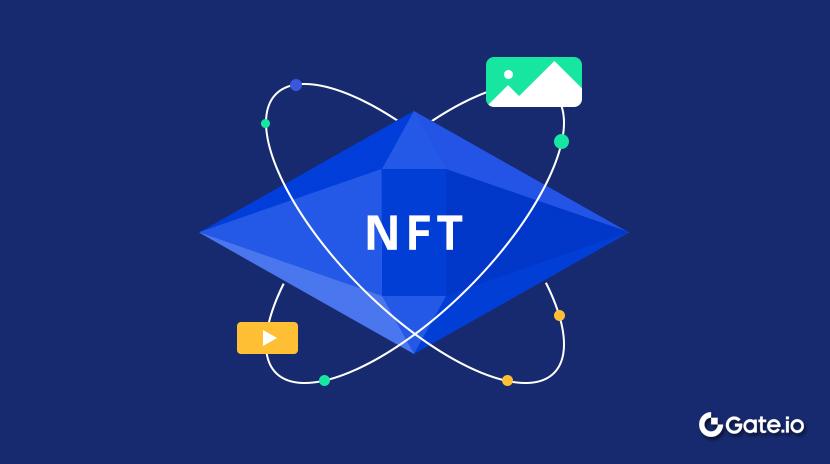What Is NFT

Non-Fungible Token (NFT) Definition and Meaning
An NFT is a uniquely identifiable digital certificate.
NFTs link a digital or physical asset to a blockchain record, providing verifiable ownership and provenance. The transaction history is publicly accessible on the blockchain ledger, which helps reduce risks of forgery or tampering.
Unlike fungible tokens that are interchangeable with one another, NFTs emphasize "non-interchangeability." Each NFT has a distinct identifier and attributes—much like every concert ticket has a unique seat number and specific value or utility.
Common NFT use cases include digital art, in-game items, membership passes, event tickets, certificates, and credentials. NFTs can be collected, traded, or transferred on marketplaces.
Why Is Understanding NFTs Important?
NFTs standardize ownership and transferability, giving you true control over your digital assets.
On traditional platforms, in-game items or privileges are typically controlled by the platform, making migration difficult. NFTs record ownership directly in your wallet, allowing assets to be moved across different apps and platforms—boosting portability.
NFTs also lower trust requirements. Their origin and transfer history are transparent and verifiable, making secondary markets more trustworthy. For example, concert tickets issued as NFTs allow organizers to set transfer limits or royalty payments, reducing scalping and speculative resales.
For creators and brands, NFTs serve as new tools for distribution and community engagement. Benefits for holders can be coded directly into smart contracts—enabling automatic airdrops, discounts, offline privileges, and fostering long-term relationships.
How Do NFTs Work?
The core concept is encoding rules into on-chain programs and assigning unique identifiers to each item.
Blockchains function as transparent accounting systems. Smart contracts—self-executing code deployed on-chain—manage NFT minting and transfers. Minting refers to generating a unique identifier for an asset within a contract and recording its ownership.
Every NFT includes metadata, essentially an “instruction manual” containing its name, image link, attributes, and more. Images and files are often stored on decentralized networks like IPFS to reduce single-point failure risk.
Ethereum’s common standards are ERC-721 (for individually numbered assets) and ERC-1155 (for mixed single and semi-fungible batches). Standards ensure wallets and marketplaces support the same set of interfaces.
When you transfer an NFT, your wallet initiates a blockchain transaction; after network confirmation, ownership shifts from your address to the recipient’s. If royalties are set by the contract, the creator receives payments automatically per transaction rules.
Typical NFT Applications in Crypto
NFTs function as both "asset containers" and "access credentials."
On exchanges and marketplaces: You can browse collectibles, initiate purchases or resales in Gate’s NFT marketplace, filter by collection, rarity, and sales history, and settle transactions in fiat or cryptocurrencies.
In GameFi: Game items, skins, and land are made tradable assets. Players can freely buy/sell them or reuse them across mini-games; prices fluctuate with supply, demand, and gameplay updates.
In DeFi: Some protocols accept NFTs as collateral for loans or fractional trading. For example, high-value NFTs can be split into multiple tokens to enhance liquidity, or used as collateral to borrow stablecoins for emergencies.
For membership and ticketing: Brands issue NFT passes that unlock exclusive channels, real-life events, or airdrops for holders. Ticketing platforms use verifiable NFT tickets to prevent forgery and overselling, with programmable resale rules.
For identity and credentials: Graduation diplomas, course certificates, event badges can be tokenized for easy verification of authenticity and ownership—ideal for resumes or community contribution records.
How to Buy NFTs?
You can acquire NFTs via centralized platforms or on-chain marketplaces.
Step 1: Register and complete security setup on Gate. Follow prompts for account security measures such as two-factor authentication to protect your assets.
Step 2: Fund your account. Buy USDT or other currencies using fiat then transfer them to your funding or spot account; or deposit crypto from external wallets to Gate.
Step 3: Access Gate’s NFT marketplace. Choose collections, check floor prices, sales history, and holder distribution; note royalties and platform fees.
Step 4: Place your order and store your NFT. Confirm price/payment method before purchasing; after settlement the NFT appears in your account or linked wallet. For on-chain usage, withdraw NFTs to a self-custody wallet if needed.
For on-chain marketplaces:
Step 1: Install a wallet and back up your recovery phrase. Popular options include MetaMask; keep recovery phrases securely offline to prevent leaks.
Step 2: Prepare Gas fees. Deposit a small amount of native currency (e.g., ETH on Ethereum) for transaction fees.
Step 3: Connect to the marketplace and filter selections. Use reputable platforms; connect your wallet, verify contract addresses, beware of fake sites and phishing links.
Step 4: Sign and complete the transaction. Submit bids or purchase at fixed prices; once confirmed on-chain, the NFT appears in your wallet address. Check for royalties, platform fees, and any authorization risks.
Recent NFT Trends & Key Data
The market is becoming more segmented in 2025 with increasing focus on utility-driven and gaming assets.
Volume & Activity: Multiple public dashboards show that between Q3–Q4 2025, monthly NFT trading volumes across Ethereum and multi-chain ecosystems fluctuate from several hundred million to several billion USD—a rebound from 2024 averages. Active trading addresses remain in the hundreds of thousands over recent months. Data sources include NFTGo, DappRadar, CryptoSlam (Q3‑Q4 2025 dashboards); methodologies vary by platform.
Sector Breakdown: Gaming assets and membership pass NFTs are gaining share. In the past half-year of 2025, game items and blockchain gaming assets have grown as a percentage of total multi-chain NFT volume versus 2024 due to user demand for playability and frequent low-cost transactions.
Multi-chain & Layer 2: Ethereum L2 solutions continue attracting NFT activity in 2025; transaction counts on chains like Base and Arbitrum are rising. Lower fees spur frequent small trades. Bitcoin ecosystem inscriptions and related NFTs maintain some market share in 2025 but see more rational activity than the peaks of 2024.
Pricing & Liquidity: Blue-chip collections show stabilized price swings; floor prices and depth increasingly depend on utility value or cash flow potential such as royalty distributions, gaming income shares, or holder privileges.
Regulation & Compliance: Ticketing and certificate NFTs are getting pilot projects in 2025; platforms emphasize KYC, anti-fraud practices, and intellectual property compliance—improving user experience and institutional participation.
Comparison: NFTs vs Fungible Tokens
Key differences lie in interchangeability and valuation methods.
Fungible tokens like USDT or ETH have units of equal value that can be exchanged one-to-one—ideal for payments or pricing. NFTs emphasize uniqueness; even within the same series each item differs by attributes or rarity—and thus price—similar to numbered tickets or collectible cards.
Technically speaking, fungible tokens use balance-based accounting where transfers subtract from sender’s account and add to receiver’s. NFTs use ID-based accounting; each transfer moves a specific numbered asset. Wallet display formats, marketplace matching engines, valuation models, and liquidity management also differ significantly between the two types.
Related Terms
- Smart Contract: Self-executing code on blockchain that enables automated transactions and verification without intermediaries.
- Gas Fees: Costs paid for executing transactions or deploying contracts on blockchain networks.
- Minting: The process of creating new NFT assets and recording them on blockchain.
- Metadata: Information describing NFT attributes—such as name, image, properties.
- Wallet Address: Unique identifier for receiving, storing, managing NFTs or crypto assets.
FAQ
Are NFTs Cryptocurrencies?
NFTs are not cryptocurrencies; they are digital asset certificates recorded on blockchain. Cryptocurrencies like Bitcoin or Ethereum have uniform value across units and are interchangeable. NFTs represent unique ownership of specific items—each one is distinct. In simple terms: cryptocurrencies resemble identical bills; NFTs act more like numbered collectible certificates.
Where Can I Buy NFTs If I Want to Start Collecting?
You can purchase NFTs via dedicated marketplaces such as Gate’s NFT section which offers various digital asset transactions. Before buying, set up a wallet (such as MetaMask) and fund it with cryptocurrency. Explore collections, bid or buy directly. Beginners should research project backgrounds and risks first—start with small amounts to get familiar.
Do NFTs Guarantee My Ownership of Digital Works?
NFTs recorded on blockchain prove that you own a particular digital asset on-chain. However, buying an NFT grants you an ownership certificate—it does not automatically provide copyright or commercial usage rights. Ownership and copyright are separate concepts; always clarify rights scope before purchase.
Why Do Some NFT Projects Suddenly Lose Demand?
NFT value depends on market demand and project popularity; when attention fades or issues emerge traders exit quickly—leading to price crashes. This is similar to speculative swings in stocks or collectibles markets. Choosing NFT projects with active communities and clear use cases helps mitigate risk.
What Is the Difference Between NFTs and Digital Artworks?
NFT is a technological form—a certificate of digital asset ownership; digital artwork is content—it may be paintings, music, videos or other creative works. Once digital art is minted as an NFT it becomes an NFT artwork with verifiable ownership and transaction history. NFT applications go far beyond art—they also cover gaming assets, virtual land, etc.
References & Further Reading
Related Articles

Top 10 NFT Data Platforms Overview

7 Analysis Tools for Understanding NFTs
